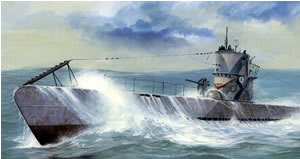
Germany used the U-boats in a war of attrition against Britain. During the First World War U-boats sunk over 11 million tons of allied shipping and in the process almost starved Britain out of the First World War. After WW1 the Treaty of Versailles did not allow Germany to develop submarine technology. However, under a veil of secrecy, great advances in submarine technology and tactics were made from 1919 to 1935. Under Hitler, Germany openly continued development of submarine technology re-arming itself with 50 U-Boats ready for the start of the conflict. One thousand boats were eventually launched in an attempt to decimate Britain's merchant navy and starve her out of the war.
In the early stages of WW2
U-boat successes were astonishing. Such was the success of the U-boat
campaign that Winston Churchill, the then Prime Minister of Britain, remarked
"The only thing that really frightened me during the war was the
U-boat peril".
Grand Admiral Donitz, the commander of the U-boat fleet, understood the potential of submarines to fight an unconventional war against the might of the British Navy and win. Unfortunately his belief was not shared by others in the German High Command who thought that the battle at sea should be fought with big guns and unsinkable battle ships, such as the Bismarck. As it turned out, huge battle ships only made headlines when the British Navy hunted and sunk them. Meanwhile the U-boats continued their hit and run campaign, inflicting heavy losses on allied shipping.
U-boat successes peaked in 1942, after which allied advances in submarine technology severely dented the U-boats ability to wage an effective campaign. An array of sophisticated depth charges, such as the hedgehog,as seen on the right, together with advanced radar made the U-boats increasingly vulnerable.
By the end of the war, 2,900 allied ships had been sunk with the loss of 800 U-boats and 30,000, out of 39,000, German sailors.

1) U-boats were most effective against allied warships.
2) U-boats mainly targeted
3) The main focus of U-boat activity was to
4) Why were U-boats so successful at the start of the war?
5) How were the allies able to combat the U-boats in the Atlantic?
6) What do you think may have been the outcome if Germany had deployed more U-boats at the start of the war? Explain.
7) Why were more U-boats not deployed early in the war?